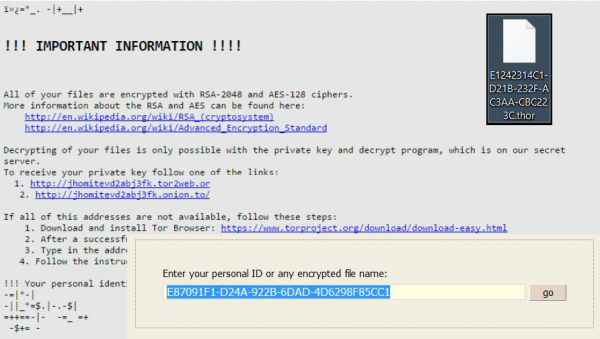Authors of the famous Locky virus have been very active creating upgrades to their notorious ransomware virus this month. Only several weeks ago after the introduction of the former Odin version, the newest kind had been discovered that creates the .thor file extension.

Besides the moderately unusual filename, this form of Locky additionally shows several improvements related to its distribution mechanisms.
The Locky crypto malware appears to have been in the circulation for nearly twelve months at this point. It hasn’t experienced even the smallest drop in its distribution volumes over this time period. It remains certainly one of the most widespread and harmful malware examples at the moment.
Additionally, in spite of significant attempts on infosec professionals’ side, this .thor variant continues to be nondecryptable. That said, the regularity of new Locky version introductions has boosted. This factor complicates the identification and decryption activities.
The earlier type of Locky named Shit didn’t live even several days. The latest modification has brought several important adjustments. Firstly, the virus has begun to add the .thor to every data file that became encrypted during the attack. Second, the owners of the malware decided to revise the type of the vicious loader.
The prevalent method Locky is presently propagating continues to be mass spam supported by the ultra powerful botnet named Necurs. The standard of the attached document has been changed to.hta. It refers to} an HTML program that initiates harmful manipulations inside the operating system at the moment an unsuspecting person click on it. These kinds of fraudulent messages can include such subject lines as: “Invoice” or “Job Offer.”
The utilization of the recent standard for the loader is probably intended for AV evasion.
As soon as the virus executable is placed onto a victim’s machine and begins executing, it activates a scan for data files. While carrying out this scan, the .thor type of Locky searches for popular forms of documents on the hard disk, detachable hard disks in the event they are connected to the |PC, and network drives too.
After that, it makes use of a mixture of AES-128 and RSA-2048 crypto algorithms to lock all the items recognized as individual ones in the course of the above-mentioned scanning process. The viral attack will move on by and change the wallpaper with a ransom note image. Additionally, it creates ransom notes usually named “_HOWDO_text” to the desktop and puts them all over encrypted folders and drives.
These notes along with the new wallpaper explain to the target how to find the Locky Decryptor web page and apply instructions on it to send 0.5 BTC for the automated decryption tool.
A remarkable characteristic of the .thor extension type of Locky is that it may lock and encrypt files in an offline manner. This indicates it does not need to connect to the outside C&C serve to obtain decryption keys, and so it’s actually an autonomous virus.
Firewalls also do not recognize it, which offers the attacker a supplementary layer of obfuscation. While decrypting .thor files without spending money on the decryption RSA key is hardly doable, the affected individuals and institutions should think about utilizing a wise forensic technology to unlock the highest priority documents.
Automatic removal of .thor ransomware
The benefits of using the automatic security suite to get rid of this infection are obvious: it scans the entire system and detects all potential fragments of the virus, so you are a few mouse clicks away from a complete fix.
- Download and install recommended malware security suite
- Select Start Computer Scan feature and wait until the utility comes up with the scan report. Proceed by clicking on the Fix Threats button, which will trigger a thorough removal process to address all the malware issues compromising your computer and your privacy.
Unlock .thor files
Thor represents a unique category of malicious software whose attack surface reaches beyond the operating system and its components, which is why removing the virus itself is a part of the fix only. As it has been mentioned, it encrypts one’s personal information, so the next phase of the overall remediation presupposes reinstating the files that will otherwise remain inaccessible.
-
Launch data recovery software
Similarly to the rest of its fellow-infections, .thor most likely follows an operational algorithm where it erases the original versions of the victim’s files and actually encrypts their copies. This peculiarity might make your day, because forensics-focused applications like Data Recovery Pro are capable of restoring the information that has been removed. As the virus further evolves, its modus operandi may be altered – in the meanwhile, go ahead and try this.
-
Take advantage of Volume Shadow Copy Service
This technique is based on using the native backup functionality that’s shipped with Windows operating system. Also referred to as Volume Snapshot Service (VSS), this feature makes regular backups of the user’s files and keeps their most recent versions as long as System Restore is on. .thor virus hasn’t been found to affect these copies therefore the restoration vector in question is strongly recommended. The two sub-sections below highlight the automatic and manual workflow.
- a) Use Shadow Explorer
Shadow Explorer is an applet that provides an easy way of retrieving previous versions of files and folders. Its pro’s include an intuitive interface where the computer’s entire file hierarchy is displayed within one window. Just pick the hard disk volume, select the object or directory to be restored, right-click on it and choose Export. Follow the app’s prompts to get the job done.

- b) Use file properties
Essentially, what the above-mentioned Shadow Explorer tool does is it automates the process that can otherwise be performed manually via the Properties dialog for individual files. This particular approach is more cumbrous but just as effective as its software-based counterpart, so you can proceed by right-clicking on a specific file, which has been encrypted by the .thor ransomware, and selecting Properties in the context menu. The tab named Previous Versions is the next thing to click – it displays available versions of the file by date of the snapshot creation. Pick the latest copy and complete the retrieval by following the prompts.

-
Data backups work wonders
Ransomware like .thor isn’t nearly as almighty and destructive in case you run regular file backups to the cloud or external data media. The virus itself can be completely removed in a matter of minutes, and the distorted information can then be just as easily recovered from the backup. Luckily, this is a growing trend, so ransom Trojans are hopefully going to become less subversive in the near future.
Verify thoroughness of the removal
Having carried out the instructions above, add a finishing touch to the security procedure by running an additional computer scan to check for residual malware activity
